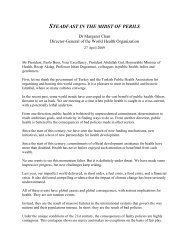The Evolution of HTA in Emerging Markets Health-Care ... - TREE
The Evolution of HTA in Emerging Markets Health-Care ... - TREE
The Evolution of HTA in Emerging Markets Health-Care ... - TREE
You also want an ePaper? Increase the reach of your titles
YUMPU automatically turns print PDFs into web optimized ePapers that Google loves.
OHE Consult<strong>in</strong>g Report for PhRMA<br />
5 January 2011<br />
Coverage<br />
population. Its fund<strong>in</strong>g comes<br />
from taxes and social<br />
contributions. <strong>The</strong>re's a mix <strong>of</strong><br />
federal, state and municipal<br />
funds. No co-‐payment is<br />
applied.<br />
For the private sector, fund<strong>in</strong>g<br />
comes from <strong>in</strong>dividuals and also<br />
from companies that pay<br />
private <strong>in</strong>surance for their<br />
employees.<br />
From the Brazilian constitution<br />
(1988), health is a citizen's right<br />
and an obligation <strong>of</strong> the State.<br />
So <strong>in</strong> theory 100% <strong>of</strong> the<br />
population is covered by the<br />
Brazilian Unified <strong>Health</strong> System<br />
(Public <strong>Health</strong> <strong>Care</strong> System).<br />
<strong>The</strong> <strong>in</strong>corporation <strong>of</strong><br />
technologies is however very<br />
slow and many "old"<br />
treatments are still <strong>of</strong>fered.<br />
21% <strong>of</strong> the Brazilian population<br />
is covered by the private health<br />
care system. <strong>The</strong> private HMOs<br />
pay for everyth<strong>in</strong>g that is used<br />
<strong>in</strong> ambulatory or <strong>in</strong>-‐hospital<br />
sett<strong>in</strong>g. Treatments that can be<br />
taken at home are not covered.<br />
This has raised many problems<br />
for oral expensive treatments<br />
like oncology drugs, for<br />
example. Many patients go to<br />
court to get their private<br />
<strong>in</strong>surers or the government pay<br />
to cover its urban<br />
and rural<br />
populations. Private<br />
medical <strong>in</strong>surance<br />
ma<strong>in</strong>ly <strong>in</strong> the form <strong>of</strong><br />
<strong>of</strong>fer<strong>in</strong>g<br />
complementary or<br />
supplementary<br />
health <strong>in</strong>surance<br />
benefits.<br />
<strong>The</strong>re are four major<br />
medical <strong>in</strong>surance<br />
schemes: (i) the New<br />
Rural Cooperative<br />
Medical Insurance<br />
cover<strong>in</strong>g nearly 850<br />
million people or<br />
more than 90% <strong>of</strong><br />
the rural population<br />
In Ch<strong>in</strong>a; (ii) the<br />
Urban Resident Basic<br />
Medical Insurance<br />
which covers over<br />
100 million urban<br />
residents (iii) the<br />
Urban Employment<br />
Basic Medical<br />
Insurance, which<br />
covers more than<br />
200 million urban<br />
employed<br />
population (iv)<br />
Private Medical<br />
Insurance which<br />
this scheme<br />
employers pay<br />
60%, employees<br />
30% and<br />
government 10%<br />
National <strong>Health</strong><br />
Insurance (NHI) is a<br />
premium-‐based,<br />
s<strong>in</strong>gle-‐payer,<br />
mandatory, near-universal<br />
<strong>in</strong>surance<br />
program run by the<br />
government to<br />
allocate health-care<br />
funds. <strong>The</strong><br />
system promises<br />
access to all<br />
necessary health<br />
care for citizens<br />
with national<br />
identity cards. In<br />
2000, the coverage<br />
already amounted<br />
to over 96% <strong>of</strong> the<br />
total eligible<br />
population, and<br />
that percentage<br />
has <strong>in</strong>creased each<br />
year s<strong>in</strong>ce NHI first<br />
49








